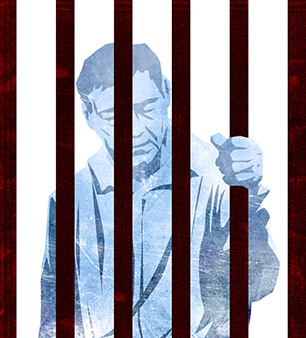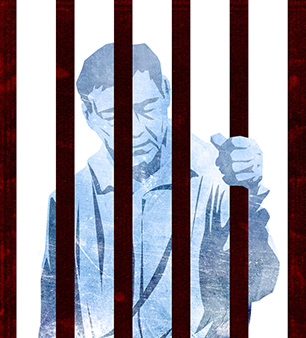 (Image: Jared Rodriguez / Truthout )The incarceration of vast swaths of the American public is now an aging issue. Our prisons have increasingly become homes for the aging, as there are now some 125,000 prisoners age 55 or older, nearly quadruple the number there were in 1995. Many of these prisoners are serving life sentences, but others soon will be released into society facing special hardships because of their age. They will join a massive and steadily increasing population of aging ex-offenders who always will bear the scars to their mental, physical and financial well-being that come with having been a prisoner in America.
(Image: Jared Rodriguez / Truthout )The incarceration of vast swaths of the American public is now an aging issue. Our prisons have increasingly become homes for the aging, as there are now some 125,000 prisoners age 55 or older, nearly quadruple the number there were in 1995. Many of these prisoners are serving life sentences, but others soon will be released into society facing special hardships because of their age. They will join a massive and steadily increasing population of aging ex-offenders who always will bear the scars to their mental, physical and financial well-being that come with having been a prisoner in America.
The Bureau of Justice Statistics estimates that between 12.3 million and 13.9 million Americans – overwhelmingly male, disproportionately people of color – have been convicted of a felony and between 5.4 million and 6.1 million served prison time. Many young men imprisoned during the early years of the prison boom in the mid-1980s are now well into middle age. More than one-third of all Americans who have spent time in prison are older than 50, and nearly 9 percent are older than 60.
According to Pew Charitable Trusts, by age 48, the typical formerly incarcerated person will have earned $179,000 less than if he had never been convicted of a crime, and this difference does not account for wages lost because of time behind bars. On average, at age 45, formerly incarcerated people can expect to earn just $23,500 per year, 40 percent less than if they had never been incarcerated. While nearly every American is facing a retirement crisis, ex-offenders will be fortunate to go into their mid-60s with any retirement savings at all.
Formerly incarcerated people face a unique challenge to their economic security as they approach retirement. Social Security is the primary source of income for nearly half of all retired Americans, but a worker is required to earn credits to qualify. Generally, Social Security eligibility occurs after ten years of work. Eligibility for Medicare comes along with it.
For the many Americans who have served overly long sentences, largely because of harsh minimum sentencing guidelines, ten years of work might be hard to come by. This is especially true in places without a “ban the box” statute, where employers are allowed to require prospective workers to divulge their criminal history then discriminate based upon that. Past incarceration reduces annual employment by nine weeks, or nearly two years of lost employment in every ten, and that does not account for years of work credit lost while imprisoned. In addition to harming formerly incarcerated people who have paid their debt to society, it is painful to the economy as a whole. According to the Center for Economic and Policy Research, the labor market struggles experienced by ex-offenders cost the United States $57 billion to $65 billion each year in lost output.
Moreover, Social Security benefits are calculated based on an average of the top 35 years in which they earned the most. As such, based on typical earnings of $23,500 annually at age 45, an ex-offender is more likely to receive a monthly benefit that puts them below the federal poverty threshold, even if possible additional income from the SSI benefit for those over 65 is taken into account. Because the official poverty line does not even adequately reflect the requirements of economic security for the elderly – for example, it does not take into account medical expenses, a large portion of a senior’s budget – a substantial portion of older ex-offenders will be unable to age with dignity as they are faced with making very difficult trade-offs to make ends meet.
While many vulnerable older Americans can turn to public assistance programs for help, the options for former felons are often much more limited. Certain felons cannot receive federal housing assistance in many jurisdictions. Twelve states, including two of the three states with the largest prison populations in the country, ban people convicted of a drug felony for life from SNAP (formerly food stamps). Twenty more have modified disqualification, such as by requiring a drug test or restoring eligibility after a specified number of years.
Meanwhile, a provision in the Senate and House versions of this year’s Farm Bill would disqualify certain former violent offenders from ever receiving SNAP in all 50 states. This disregards the idea of rehabilitation that sits at the center of any compassionate criminal justice system. In addition, because the ban is universal, it would catch in its net older poor African-Americans who were wrongfully convicted of a felony by all-white juries in the Jim Crow South, unfairly punishing them for wrongdoings they did not commit.
Even in those states where drug felons are not disqualified for life from SNAP, older Americans remain the least likely group to access the benefit. According to the most recent data, about one-third of all eligible people over 60 are actually enrolled in SNAP, compared with three-quarters of the eligible population as a whole. Research by the US Department of Agriculture on SNAP access in Texas shows that access rates decline steadily as age increases.
But the damage does not end with their wallets. The psychological and mental tolls the American corrections system takes on the incarcerated are perhaps greater than we who have never experienced it can fathom. Research has shown that the average prisoner has a health status comparable to someone 10 to 15 years older than their calendar age. Seventy percent of older adults in prison have some type of medical problem, with rates of physical and mental disabilities such as dementia much higher than the general population of a similar age. According to recent research by Evelyn Patterson, associate professor of sociology at Vanderbilt University, each year spent in prison decreases life expectancy for the typical ex-offender by two years.
In effect, our country’s broken criminal justice system has condemned substantial parts of whole generations to impoverishment and ill-health of mind and body in their old age. Add to this voter disenfranchisement laws in many states, and we have fashioned a human rights disaster – a permanent under-caste of poor old people who are denied even the tiniest voice in our democratic system.
How can we mitigate this issue and ensure that our incarceration nation ages with dignity? On the ground, community-based organizations that work with seniors should be enlisted to help with the special needs of the formerly incarcerated community, because many high-needs areas overlap with areas with a large number of graying ex-offenders. Correctional facilities and parole boards should screen older parolees for benefits or connect them with groups in the aging network who can do so. Older people leaving prison are unlikely to be aware of eligibility determination or how to apply for many public assistance programs.
Unfortunately, there are very few pilot programs that can be looked to as examples for how senior centers and the rest of the aging network can work with formerly incarcerated individuals. In San Francisco, the Senior Ex-Offender Program at the Bayview Hunter’s Point Senior Center funded by the San Francisco Sheriff’s Office provides counseling, support groups and mental health services to older ex-offenders. This model should be examined for scalability to other high-needs areas in the United States. Current policy tends to focus on recidivist rates as a means of evaluating efficacy of re-entry programs; for younger ex-offenders this may be appropriate, but for older ex-offenders, who have a recidivist rate of less than 1 percent regardless of their crime, it is less meaningful.
Ultimately, though, fixing our broken criminal justice system is the best way to mitigate this catastrophe in the future. The usual slate of recommendations should be on the table: an end to lifetime bans from public assistance programs, reform of minimum sentencing guidelines, proactive connection of parolees to the labor market and swift and certain sanctions as a replacement for prison time, among others.
In addition, prisoners who do work and earn pennies for their labor in private prisons should at least receive some Social Security credit, with these credits awarded retroactively to ex-offenders who worked in the prison-industrial complex previously. Finally, the special minimum benefit for Social Security should be at least 125 percent of the official poverty threshold, a policy that would help many more Americans than just ex-offenders.
America is aging, and with it ages the largest population of prisoners and former prisoners in the industrialized world. This is no longer just an issue of criminal justice. It has become an issue of elder justice and retirement security, and it is time the aging community supports this large and growing group of older Americans.
Join us in defending the truth before it’s too late
The future of independent journalism is uncertain, and the consequences of losing it are too grave to ignore. We have hours left to raise the $12,0000 still needed to ensure Truthout remains safe, strong, and free. Every dollar raised goes directly toward the costs of producing news you can trust.
Please give what you can — because by supporting us with a tax-deductible donation, you’re not just preserving a source of news, you’re helping to safeguard what’s left of our democracy.
